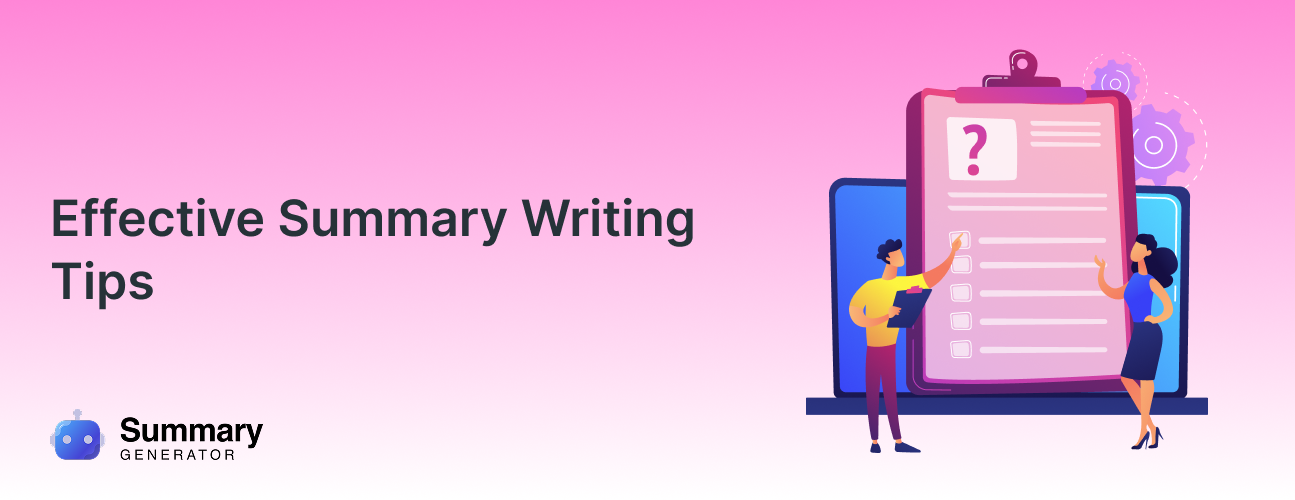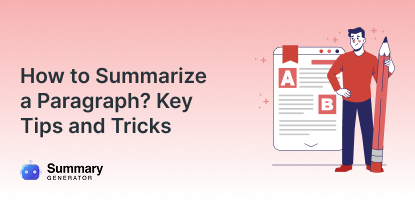Ever opened a 20-page article and instantly felt your soul leave your body? That’s exactly why summary writing exists: to turn all that information overload into something digestible without totally zoning out by page three.
Summary writing may sound simple: “just shrink the text.” But honestly? It’s easy to get stuck. You either write too much and end up rewriting the original, or write too little and lose the whole meaning. And those stiff, robotic summaries? They’re about as useful as a dictionary read aloud by text-to-speech. So yeah, if you’ve struggled with writing a summary that works (and doesn’t put readers to sleep), welcome to the club.
This blog’s going to break it all down, from understanding the material to trimming the details, and most importantly, how to sound human while doing it.
Why Do Most Summaries Fall Flat?
Before we even jump into the “how,” let’s talk about why so many summaries just don’t hit the mark. Here’s the answer:
- They’re either too detailed (basically the original, just reworded)
- Or too vague (leaves people more confused than before)
- Sometimes people just copy and paste parts from the source (big nope!)
- Or miss the tone and intent behind the text (which matters more than you think)
If your summary doesn’t reflect the intent and main message of the original, it’s not a summary at all. It’s just a jumbled paragraph of words pretending to be useful. Make this process easier by using a summary generator to condense your text.
Now, let’s build the Foundation for effective summary writing first!
Step 1: Understand the Material Before You Write a Word
You can’t summarise what you don’t understand. Right? But seriously, don’t start writing until you’re confident about the original content. As that quick skim while half-checking Instagram doesn’t count as “reading.”
Here’s how to actually digest content before summarising:
- First Pass: Just Read
- Just read. No highlighting, no stressing about notes.
- Let the main idea marinate in your brain.
- Second Pass: The Surgical Read
Now read it with a purpose to observe:
- Core Idea: What’s the one thing the writer wants to convey
- Key Supports: What 2-3 points actually hold this argument up?
- Stuffings: Those random stats/stories even the author forgot they included? Yeah, those can go.
Pro Test: Explain it to your most impatient friend in 30 seconds. If they understand, you did great. If they look bored or confused, start over.”
Good summarising isn’t about shrinking words. It’s about crystallising meaning. Get that right first.
Step 2: Structure Without the Stiffness
Nail the core ideas? Organise them so humans actually want to read your summary.
Craft your intro section:
- Mention the source title and author (if available)
- Sum up the overall focus or argument
Example:
“Emily Davis’s essay on digital education explores three challenges in remote learning, ultimately arguing that tech can’t replace human interaction in classrooms.”
Then move to the body:
- Follow the original structure, unless you have a good reason to change it.
- Each paragraph should tackle one big idea or section.
- Use transitions to keep the writing flow smooth.
Test It:
If your summary sounds like a broken list, add transitions.. If it feels too much like an essay, remove extra formal stuff.
Goal: A smooth summary that readers forget they’re getting the condensed version.
Step 3: Write in Your Own Words
Copy-pasting with fancy synonyms isn’t summarising; instead, it’s plagiarism with a thesaurus. Here’s how to actually own it:
A good summary is:
- In your own words
- Way shorter than the original
- Free of opinions or personal reactions
- Focused only on what matters most
A good summary is similar to a screenshot showing only the important part. If it sounds like you, you’ve done it right.
Step 4: Preserve what matters the most
First drafts always run long (NO worries, it’s normal and happens to most of us!). So, you have time to cut things down without holding back. That’s where editing comes in.
Trim with this checklist:
- Use everyday language, don’t overcomplicate things
- Cut out all jargon (unless absolutely required)
- Remove repetitive points
- Stick to the essentials: what would you need to remember?
And yes, don’t be afraid to delete a lot. It’s better to be short than too long.
Step 5: The 6-Step Summary Writing Method
Summarising doesn’t need to be a guessing game. This method works whether you’re condensing a tweet thread or a textbook:
- Map up the Content:
Slice the original into logical chunks. These can be paragraphs, chapters, arguments—whatever makes sense. You’re just creating a roadmap.
Example: “Intro → Problem → Analysis → Conclusion”
- Intro: “Why remote work fails”
- Problem: “The loneliness factor”
- Solution: “Hybrid coffee chats”
- Distinguish between major and minor points
In each section, ask yourself:
“If I had to tweet this section in one sentence, what would it be?” That’s the major point.
For Instance:
In a report about climate change, the core point might be rising temperatures. The graphs, case studies, and stats? Nice to know, but probably not summary-worthy unless crucial.
- Remove the extras
Now comes the satisfying part:
- Trim the details.
- Ditch long-winded examples, random side notes
- Repetitive explanations.
If it’s not carrying the message, cut it.
- Follow the Breadcrumbs
Transition words are cheat codes:
- “However” = “Here comes the plot twist”
- “Therefore” = “So here’s why this matters”
- “For instance” = “Optional evidence ahead”
Sometimes, a single “but” or “therefore” can signal the entire point of a paragraph. Don’t skip over those little words; they’re the real plot twists.
- Refine (if needed)
Only reorganise if the original structure is confusing.
- Good reason: An essay that hides its best insight on page 10? Move it front and centre.
- Bad reason: Just because you prefer a different order.
(Pay attention to these minute details and feel the difference yourself!)
- Keep your opinions out.
This one’s tough (Your subjective approach is not at all welcomed here). A summary is a mirror, not a commentary. Save your opinions for reviews or discussions.
Final Step: Review & Refine
Read it aloud. If you:
- Sound like a Wikipedia bot → Add humanity
- Get lost halfway → Simplify
- Hit 90% of key points → Ship it
ASK YOURSELF:
- Did I capture the heart of each section?
- Is this truly in my words?
- Would someone who missed the original get it?
- Does it flow, or does it jerk around?
Capping Off:
In a nutshell, true summarisation isn’t scissors meeting paper; instead, it’s a spotlight cutting through fog. Those effective strategies we’ve shared? They’re your helping hands. When you identify key sections, separate major from minor points, and trim with purpose, you’re not just shortening text. You’re practising the art of essentialism
It’s that moment when scattered thoughts click into focus, when someone hands you the heart of an idea without the heavy lifting. This is the skill that turns:
- Chaotic meetings into clear next steps
- Dense articles into actionable insights
- Rambling stories into memorable moments
The magic lies in what you choose to illuminate. Not every fact deserves the spotlight. Not every detail needs a voice. Your job? Find the core, the pulse, the why, and let that shine.
Because in the end, people won’t remember the length of what you said. They’ll remember how clearly they saw.



